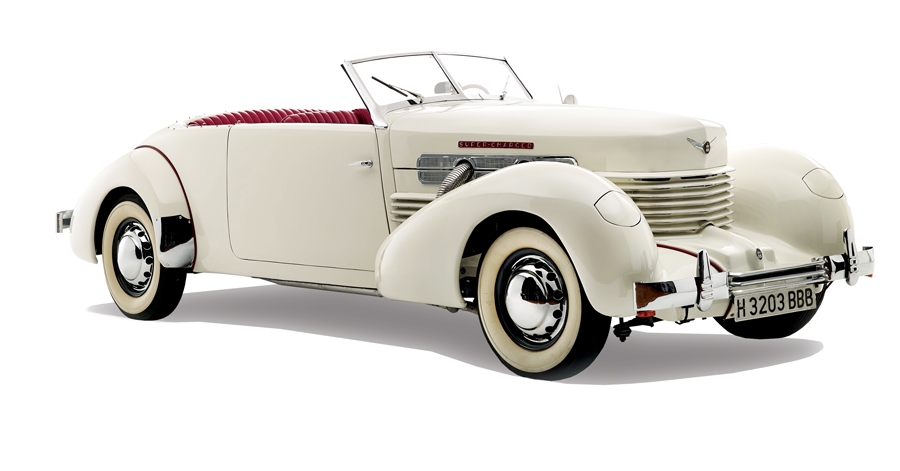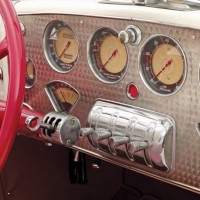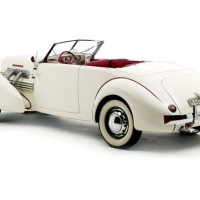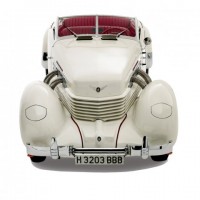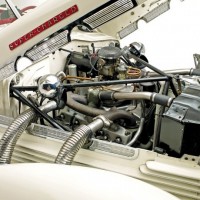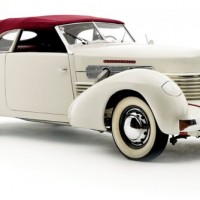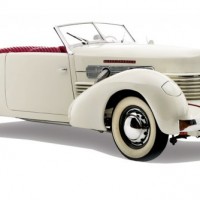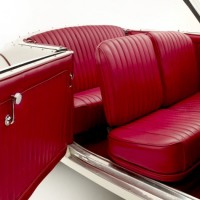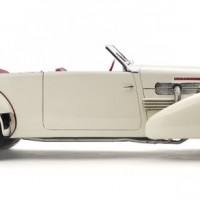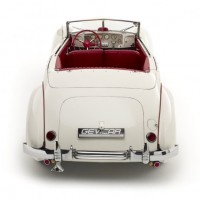One of the few automobiles deemed worthy of inclusion in the Museum of Modern Art in New York — and arguably the most easily recognized American car of all time — the Cord 810 debuted in November 1935, receiving a rapturous reception at U.S. automobile shows. The work of a team led by Duesenberg designer Gordon Buehrig, the 810 body style, with louvered “coffin” nose, streamlined, spat-shaped wings and absence of running boards, would prove immensely influential. Its distinctive features were borrowed by most mainstream manufacturers by the decade’s end.
The Cord was redesignated 812 for 1937, when custom sedans on a longer wheelbase joined the four-model range. Priced competitively in the $2,000–$3,000 range, the 810/812 should have been a huge success, although, sadly, this was not to be.
This example of a car widely recognized as one of the top 10 automotive designs of all time represents the model in its ultimate 812 supercharged configuration. The current vendor’s father, a Spanish collector of fine automobiles, purchased the Cord in South America in 1985. Presented in generally excellent condition, this sublime Cord 812 is offered with restoration invoices, Spanish registration document and FIVA papers.
SCM Analysis
Detailing
| Vehicle: | |
| Years Produced: | 1937 |
| Number Produced: | 196 |
| Original List Price: | $3,060 |
| SCM Valuation: | $160,000–$210,000 |
| Tune Up Cost: | $300 |
| Distributor Caps: | $100 |
| Chassis Number Location: | Plate on right side of cowl |
| Engine Number Location: | Stamped on block, on boss at left front |
| Club Info: | ACD, CCCA |
| Website: | http://acdclub.org |
| Alternatives: | 1931 Ruxton, 1929–32 Cord convertible sedan, 1937–39 Packard Super Eight open |
| Investment Grade: | B |
This car, Lot 416, sold for $177,140, including buyer’s premium, at Bonhams’ sale in Paris, FRA, on January 5, 2015.
It might be a stretch, but it can be said that without Montgomery Ward there might not have been a Cord 810/812.
Tomes have been written about E.L. Cord’s mastery of marketing and his rapid ascent to the pinnacle of the automotive world. At a young age, he turned around Auburn by dressing up excess inventory and revamping the dealer network.
When Auburn turned a profit, Cord went on a shopping spree. He bought Duesenberg out of bankruptcy court in 1926. A few years later, he bought the body builder Central Manufacturing and engine maker Lycoming. Next were Stinson Aircraft and Columbia Axle, followed with New York Shipping. Checker Cab was also added to the empire.
In the late 1920s, the money was rolling in and the future looked bright. Auburn sold 31,000 automobiles in 1931, but the company was headed toward extinction as the Great Depression squeezed the middle class — Auburn customers — from the marketplace. As the Cord Corporation prospered, based on investments in aviation, the Auburn Automobile Company faced declining sales, diminishing assets and increasing debt.
A new designer — and design
In 1927, Gordon Buehrig was one of Harley Earl’s first hires in GM’s new Art and Color Section. After a stint at Stutz, Buehrig was hired as chief designer at Duesenberg. This was to become a revolving-door relationship, as he returned to GM in early 1933 — only to return to Duesenberg when he was assured that they were serious about proceeding with a baby Duesenberg.
Buehrig’s design was based on a concept he sketched while at GM, and it was built as a one-eighth-scale clay model. The proposed car had front-wheel drive, pontoon fenders and non-functional louvers trimming the front of the hood.
The results for 1933 were, however, a disaster, with sales of 5,000 or so cars barely paying maintenance costs on the buildings, and 1934 results were even worse. It was decided that Auburn needed more help than Duesenberg, and the new project became the Cord.
The problem was funding. The idle factories were tooled to produce other products, including steel kitchen cabinets, which appealed to buyers at Montgomery Ward and produced enough profit to proceed with the Cord project.
Five prototype sedans were produced — even though the Cord board had rejected the project at the end of 1934. It was an obvious end run around the corporate mandate. So when Cord executives went back in mid-1935 for approval, they had to use photographs of the clay model rather than the actual prototypes. Approval was granted, and the first of the prototypes left for California on July 29, so E.L. Cord could see the car for the first time. No one seemed to question how a car could be approved on July 8 and be on the road in a mere three weeks.
The cars appeared at the New York and Los Angeles auto shows even though they had wood transmissions — not seen by the public — and were an incredible success. There were more than 7,500 requests for more information, and 3,000 people wanted one right away.
Someone, however, made the mistake of promising delivery by January 1, 1936, and the inevitable delays were costly. American car buyers love the new and different, but they rarely rush to buy it, and that was the case with the Cord 810. About 450 of the unsold cars were returned to the factory and renumbered as 1937 812 models.
On August 16, 1937, E.L. Cord announced he was selling his holdings in Cord Corporation, and the next day production of the 812 stopped. Only 2,320 Cord 810/812s had been produced.
One of 196 supercharged convertibles
Our subject Cord 812 Supercharged was stated to have been located in South America in 1985, although it is not listed in Cord records as an export model. It could, of course, have been sent there after the fact.
The car is equipped with the correct supercharger, and it is one of only 196 812 convertible phaeton sedans so equipped. It is fitted with an attractive maroon top, although that color is not listed as being available. Factory tops were tan Wexford cloth, and black was offered at extra cost. Cord would, however, do anything for a price, so it would be difficult for a concours judge to deduct for that.
This Cord 812 was restored about 10 years ago and received a Best in Class at the prestigious 2007 Concorso d’Eleganza Villa d’Este. Based on the photographs in the Bonhams catalog, it appeared to have been well maintained. It is assumed that the issues that plagued the early Cords such as slipping out of gear and vapor locking have been resolved. As such, this was a solid transaction all around — and fair for all parties concerned. ♦
(Introductory description courtesy of Bonhams.)
